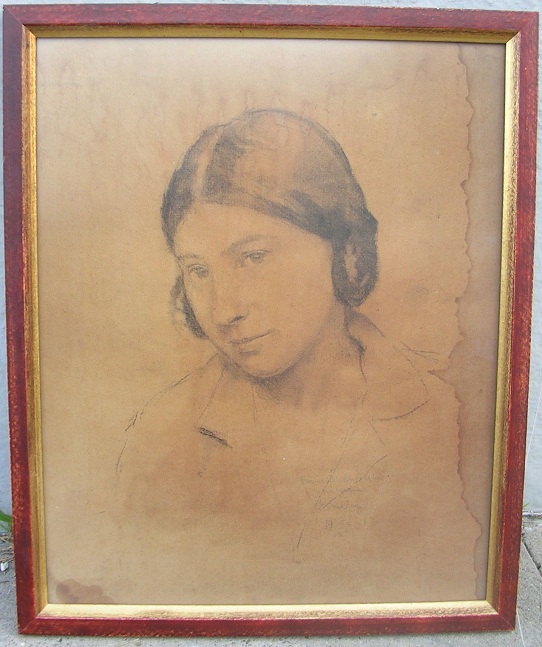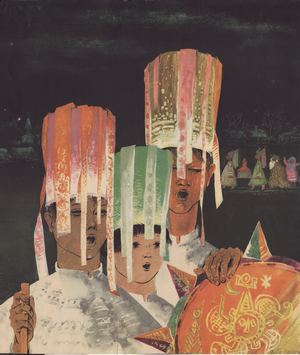 français français magyar magyar deutsch deutsch |
Talking with Angels
{ documents } |
 français français magyar magyar deutsch deutsch |
Talking with Angels
{ documents } |
|
Gitta Mallasz’ artworks Portrait of Hanna Dallos This portrait of Hanna Dallos is probably the first work we know of by Gitta Mallasz. It is not signed, and the handwritten inscription that may have been added later (“To the unforgettable memory of Hanna...”) does not give any information about its author. However, Hanna’s sister-in-law who inherited this artwork assures us that it is by Gitta. Hanna and Gitta would have been around 20 by then. It would therefore date from the time when Hanna finished her studies, got married and founded a graphic and decorative arts workshop with her husband Joseph Kreutzer and her friend Gitta.  Gitta Mallasz - Portrait of Hanna Dallos (courtesy of Dr. Vera Dallos-Pinter) Production in the Mallasz-Dallos Workshop before and during the war The workshop was established in 1928 by Hanna Dallos and her husband in Buda, on Ilonka Szabo Street (today Ilona Street), under the Fishermen’s Bastion. They worked in advertising and promoted tourism in Hungary, they produced greeting cards and posters, illustrated books, designed fabrics... It was around 1934 that Gitta Mallasz joined her friends. Thanks to the cover she provided, the workshop was able to continue its activity until 1942. Most of what came out of the workshop bore the signature “MallaszDallos” or more rarely “DallosMallasz”. Few works are signed “Dallos” or “Mallasz”. It is therefore difficult to know by whom these works were made. One can only rely on comparisons with works that can be attributed with certainty to one or the other. But it cannot be ruled out that the two friends collaborated on some of them either.
You
can see other posters designed by Hanna Dallos and Gitta Mallasz in the
1930s in an article published in 2013 in Artmagazin: Szépvagy, gyönyörű vagy
Magyarország (‘Hungary,
you are
beautiful, you are splendid!’ - title of a very popular song from the
1920s).
Production in the Gitta Mallasz’ workshop after the war After the war, Gitta Mallasz took over the ruined workshop of her friend Adrienne Frankovszky (Adri) at 4 Batthyányi Street. It became her apartment and workshop. Initially, Gitta, Adri, Agi (Agnčs Péter) and Ruszi (Erzsébet Rusznyak) who were two women she knew from Katalin, met to read the Teaching. When more work became available, the place resumed its function as a workshop. And later on, the small group gradually broke up. Adri was the first to leave; seriously ill, she died in 1953. Then Ruszi left in 1957 to work from home. In 1960, when Gitta left for France, only Agi remained; she kept the workshop until 1984. The workshop’s production was very diversified. In addition to advertising and tourism promotion for Hungary, the documentation that remains from that time contains a lot of teaching material: a booklet for communist youths, teaching notes for games and notably a series of song books for primary schools based on the Kodaly method. Gitta and Ruszi illustrated the books and Agi did the graphic design for the musical scores. To
view the slideshows, click here
Work for the Hungarian State Folk Ensemble Between the end of the war and her departure for France, Gitta Mallasz was also a costume designer for Rábai Miklós’ Állami Népi Együttes (Hungarian State Folk Ensemble). She accompanied the troupe on its international tours and served as their interpreter.
Hungarian Rhapsody, a book published in 1956 and translated into several languages, is a remarkable illustration of both the richness of Hungarian folklore and the talent of Gitta. One of her 32 drawings is reproduced here.
Gitta Mallasz’ artistic activity in France In France, Gitta resumed her activity as a graphic designer to earn a living. She illustrated record covers for Vox and painted furniture in the traditional Hungarian style. She also produced more personal artworks.
Children’s books Gitta illustrated several children’s books both in Hungary after the war and in France. As these books are copyrighted, we cannot reproduce them here. Anyone interested can request private access to the illustrations in the Hungarian books (Contact). Other works  Untitled (year unknown) (Marguerite Kardos’ private collection) Translated by Treharne Translations |